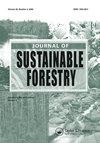在查科省中部西部的森林特征,阿根廷
IF 1.8
4区 农林科学
Q3 FORESTRY
引用次数: 0
摘要
进行这项工作的目的是产生面向可持续管理的生态和林业资料。水平结构采用Curtis和Macintosh的重要值指数进行评价,垂直结构采用Finol的方法进行评价。通过社会学位置指数,估算自然更新率和扩展重要值指数,推断森林生态系统的持久性。植物区系主要有桃心科、夹竹桃科、豆科、桑塔科、鼠李科、槐树科、石竹科、榆科、竹叶科、辣椒科、Borraginaceae和牛膝科。在水平结构中,排名最高的是金合欢(Acacia praecox),其次是青冈(Schinopsis balansae)、白脉(Aspidosperma quebracho blanco)和孔豆(Prosopis kuntzei)。从社会学角度看,最具代表性的是金合欢,其次是美洲巴塔哥拉、长叶沙棘、孔竹和白刺草。再生价值最好的树种是灌木层的黑桃树和金合欢,乔木层的美洲巴塔古拉。扩大的重要性指数巩固了群落中金合欢的分类,并给予了较好的分类,如巴南芥(Schinopsis balansae)、毛茛(Aspidosperma quebracho blanco)、孔豆(Prosopis kuntzei)和美洲巴塔哥拉(Patagonula americana)。本文章由计算机程序翻译,如有差异,请以英文原文为准。
Characterization of a forest in the center west of the province of Chaco, Argentina
This work was carried out with the purpose of generating ecological and silvicultural information oriented to sustainable management. The horizontal structure was evaluated using the importance value index of Curtis and Macintosh, the vertical structure using Finol’s methodology. Through the sociological position index, the percentage natural regeneration and the extended importance value index were estimated in order to infer the permanence of the forest ecosystem. The floristic composition was represented by species of the families Anacardiaceae, Apocynaceae, Fabaceae, Santalaceae, Rhamnaceae, Sapotaceae, Simarubaceae, Ulmaceae, Zygophyllaceae, Capparidaceae, Borraginaceae and Achatocarpaceae. In the horizontal structure, the species with the highest rank was Acacia praecox, followed in order of importance by Schinopsis balansae, Aspidosperma quebracho blanco and Prosopis kuntzei. According to sociological position, Acacia praecox was the most representative species, followed by Patagonula americana, Schinus longifolius, Proposis kuntzei and Aspidosperma quebracho blanco. The species with the best regeneration values were Achatocarpus nigricans and Acacia praecox in the shrub layer and Patagonula americana in the tree layer. The extended importance index consolidated the category of Acacia praecox in the community and gave a better category to Schinopsis balansae, Aspidosperma quebracho blanco, Prosopis kuntzei and Patagonula americana.
求助全文
通过发布文献求助,成功后即可免费获取论文全文。
去求助
来源期刊

Journal of Sustainable Forestry
Social Sciences-Geography, Planning and Development
CiteScore
3.90
自引率
12.50%
发文量
42
期刊介绍:
Journal of Sustainable Forestry publishes peer-reviewed, original research on forest science. While the emphasis is on sustainable use of forest products and services, the journal covers a wide range of topics from the underlying biology and ecology of forests to the social, economic and policy aspects of forestry. Short communications and review papers that provide a clear theoretical, conceptual or methodological contribution to the existing literature are also included in the journal.
Common topics covered in the Journal of Sustainable Forestry include:
• Ecology, management, recreation, restoration and silvicultural systems of all forest types, including urban forests
• All aspects of forest biology, including ecophysiology, entomology, pathology, genetics, tree breeding, and biotechnology
• Wood properties, forest biomass, bioenergy, and carbon sequestration
• Simulation modeling, inventory, quantitative methods, and remote sensing
• Environmental pollution, fire and climate change impacts, and adaptation and mitigation in forests
• Forest engineering, economics, human dimensions, natural resource policy, and planning
Journal of Sustainable Forestry provides an international forum for dialogue between research scientists, forest managers, economists and policy and decision makers who share the common vision of the sustainable use of natural resources.
 求助内容:
求助内容: 应助结果提醒方式:
应助结果提醒方式:


